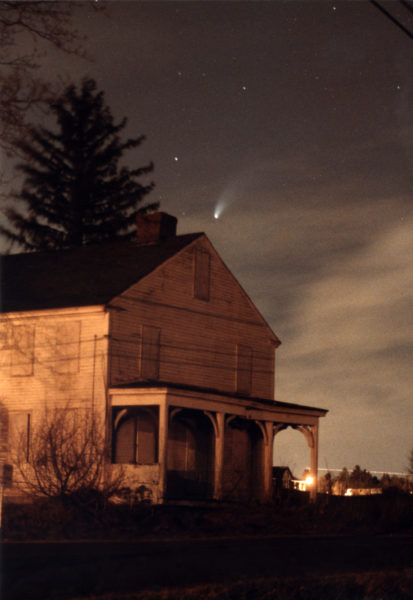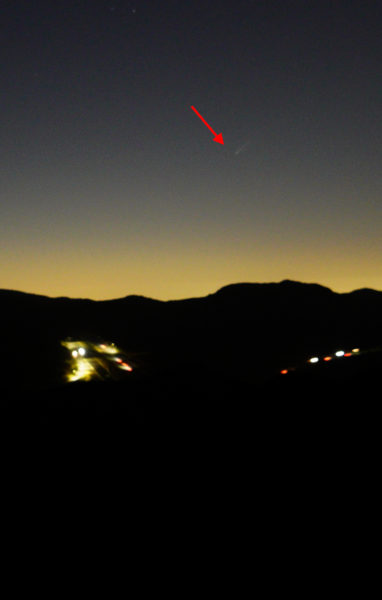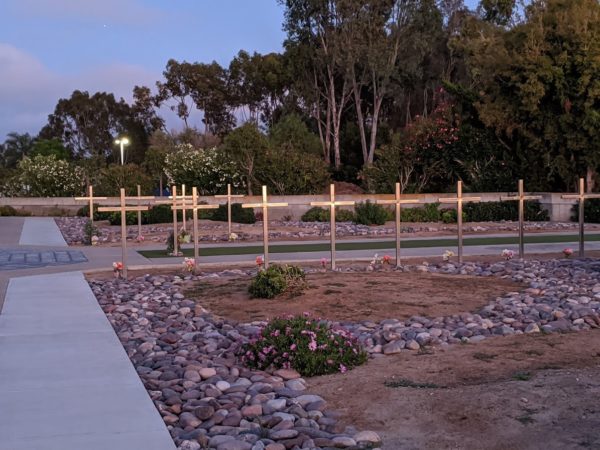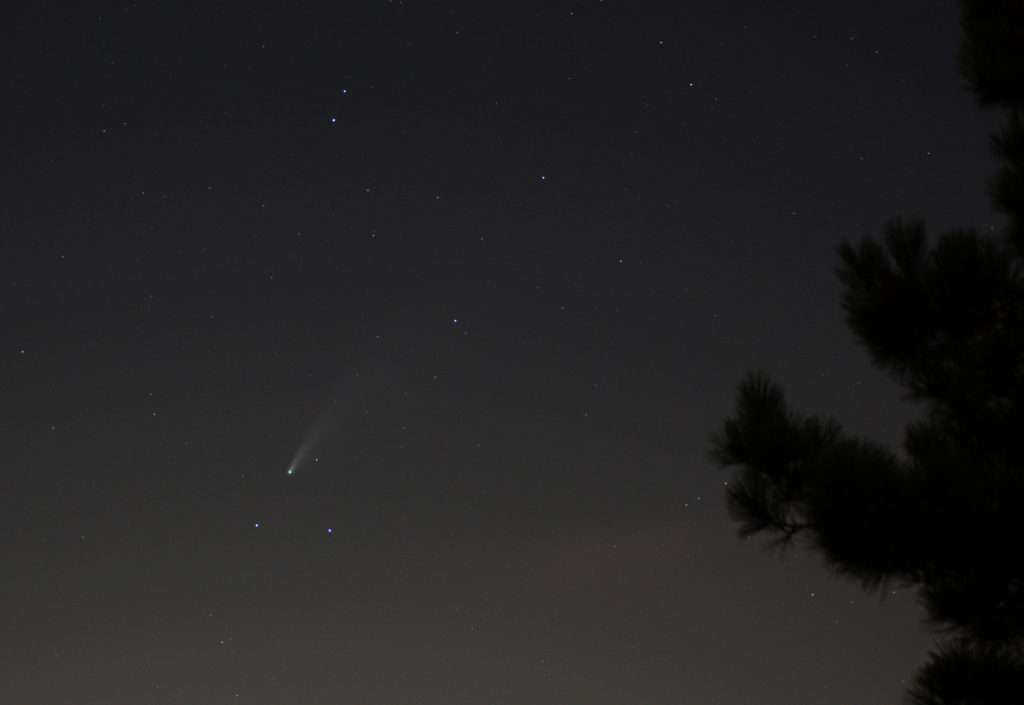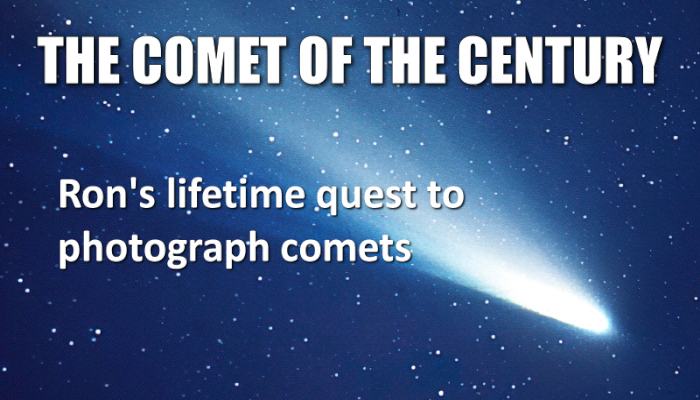
Writing a story for audio is different than one intended for text. Therefore, Ron presents the following story two different ways: audio and text. If you’d like to read the story, continue with this blog post. But if you want to sit back and hear it as a complete audio production, hit the play button (or download the file to your phone) and listen to the most recent episode of Ron’s 15-year old podcast called Griddlecakes Radio®: Exploring the Lost Art of Audio Storytelling.
The sun set into the Pacific, initiating an 80-minute wait for when it would be dark enough for me to see the comet that I’d been chasing for the past week. I took in a deep breath of the desert air, exhaled, and settled in with my thoughts. I turned to identify a sound to my right. That’s when I saw something that one would only expect to see in a movie: a Benedictine Monk emerging from the shadows of the cloisters. I smiled to myself. It had been a long journey. My attempts to photograph Comet NEOWISE had been inhibited by clouds, light pollution and a standoff with a skunk. And yet, here I was, standing in a dark cemetery, with a monk approaching. That’s when I wondered, “How on earth did I get here?”
![]()
December, 1973. It was all over the news. Comet Kohoutek was going to be a spectacular sight for all to see. We were about to be visited by The Comet of the Century. Ten-year-old me fell for the hype. I read every astronomy book in my Elementary School library. I especially liked the oversized ones, packed with full-page photos of stars, supernovas, and comets with their huge tails that filled the night sky.
I learned that comets were big pieces of ice, or more colloquially, dirty snowballs–something that a kid growing up in New England knew quite a bit about. You see, dirty snowballs are made from the snowbanks of freshly plowed streets. And while they were unsightly, more importantly, dirty snowballs are illegal in snowball fights as their salt, sand and gravel posed dangers to one’s opponents.
When a comet is far away from the sun, it’s just an ugly, dirty snowball. But when it gets close, magic happens. Solar radiation heats the snowball to start a process called outgassing. Solar winds then blow these gasses away, creating a wispy tail that paints itself across the constellations. This was something I had to see.
And so on one December evening in 1973, I went hunting for the Comet Kohoutek. A flashlight guided me through the darkened woods as the snow crunched under my boots. A few minutes later, I was standing in a clearing that offered an open view of the sky. This was it. I was finally going to see the Comet of the Century. I looked up with the anticipation and wonder that only a ten-year-old can have and saw…nothing…nothing but stars. Weird.
The justifications began. “Maybe I was too too early? Yeah, that must be it.” And so I waited. I stood in the cold for what felt like an eternity. The tip of my nose felt numb. My cheeks stung. And my toes started to hurt. “Where was it?”
The television newscaster promised me a big bright comet flying directly overhead. Little did I know that my expectations were totally unrealistic. First of all, comets don’t zip across the sky–they hold their positions among the stars. In other words, you need to know where to look for them. Second, comets aren’t as bright as the newscaster alluded to. Even the brightest of comets are faint to the naked eye.
I don’t know how long I waited before giving up and using my flashlight to illuminate the long path of failure home. Although I wouldn’t know it at the time, I had just fallen behind in a multi-decade game of cat and mouse. Comets 1, Ron: zero.
Comet Kohoutek was a worldwide flop. And although I didn’t see this dirty snowball, I vowed to see the next one…whenever that was. That’s when I learned about Halley’s Comet.
Halley’s comet had appeared over humans about 28 times between its first recorded instance in 239 BC and 1682. Yet nobody, until Sir Edmond Halley had connected these multiple appearances to a single comet. After studying records from 1531, 1607, and 1682, Halley predicted that this comet would return to earth in 1758. Although he died sixteen years before the dirty snowball proved him right, his prediction earned him the honor of the comet’s namesake.
I did the math. Since Halley’s Comet last visited our little corner of the solar system in 1910, it would reappear in 1986. I just had to wait thirteen years…infinity to a grade-schooler. “Thirteen years,” I thought. Not only would I have to wait twice my age for the event, I’d be an old man in 1986. I’d be twenty-three.”
Much happened between 1973 and 1986. I graduated from High School and College and had moved to Los Angeles to start my engineering career.
That’s when the hype started. Halley’s Comet would be The Comet of the Century.
Like Kahoutek, Halley’s comet also proved to be a dud. Not only was it difficult to see with the naked eye under the best of conditions, my view was obscured by the glare of the Los Angeles city lights. After waiting thirteen years, I’d fallen father behind in my little game. Comets: 2; Ron: 0.
My quest to see a comet was now in deep jeopardy because Halley’s comet is the only known dirty snowball with a period short enough to be seen by the same generation.–and that’s only if you were born at the right time. My timing wasn’t so good. You see, in 2061, I’ll almost be a centenarian.
Therefore, the only way for me to view a comet with my own eyes would involve luck.
A new comet had to be discovered. Such luck occurred nine years later when Alan Hale and Thomas Bopp discovered a new comet on July 23, 1995–two full years before it would be visible to the naked eye.
And just just like it had with the comets of Kohoutek and Halley, the closer it got, the more exaggerated the hype. Hale-Bopp would be The Comet of the Century.
Yeah. I wasn’t falling for that again.
But there was something different about this comet. Reports from all over the world described how everyday people could see Hale-Bopp with the naked eye.
In the eleven years since Halley’s Comet, I’d gotten married and moved back from the bright lights of Los Angeles to the dark skies of northern Massachusetts. I went outside, looked to the constellation where Hale-Bopp should have been and saw…nothing. Not again!
But that’s when something appeared in the corner of my eye. A line…like the tail of a comet. I concentrated my gaze and saw something out of place. A star. A fuzzy star exactly where Hale-Bopp was supposed to be.
It was odd. If I looked directly at it, I couldn’t see the tail. But if I looked away slightly, I saw a prominent tail in my peripheral vision. I had finally seen my first comet, but it looked nothing like the spectacular photographs being published in the newspapers and magazines.
But why?
The reason has to do with one’s retina. Remember that High School anatomy class where we learned about rods and cones? Don’t worry–I needed to look it up too. Cones see color and rods see black and white. The retina’s foveal field–the area where the image of what you are looking at is projected–is packed with cones that capture a high-definition, color image. The area outside of the foveal field–which makes up your peripheral vision–contains more rods than cones. Since rods are more light-sensitive than cones, they can pick up fainter objects, such as comet tails.
This idea of light sensitivity is relevant because the human eye doesn’t have the sensitivity to see a comet’s full majesty. That’s where photography comes in. Film is much more sensitive to light than the human eye.
And so, if I was going to capture an image of Hale-Bopp, I’d need a camera, tripod, and a shutter release–all things that I’ve had since I was sixteen years old. I set up my tripod across the street from an old abandoned farmhouse and waited for nightfall. Since Hale-Bopp was situated high in the sky, I aligned it with the corner of the roofline, took a few shots, and sent the film off for processing.
I tore open the envelope to see what I’d captured.
There it was. A white comet with a white tail, over a farmhouse. After 24 years I was finally on the board. Comets 2; Ron: 1.
But the image wasn’t perfect. You see, because we live on a big blue marble that rotates about its north-south axis, celestial bodies appear to rotate slowly around the North Star. Have you ever seen a picture of star trails? They’re created because the camera captured all the locations that the stars occupied while the shutter was open. And even though mine was only open for about 30 seconds, the rotation of the earth in that half-minute caused Hale-Bopp to move ever-so-slightly, creating an image that looked more like an oval smudge with a blurry tail as opposed to a crisp, round nucleus and wispy tail.
But, I learned. The next time–if there was a next time–I’d need to keep that shutter speed down.
I waited 13 years for Halley’s Comet; 11 years for Hale-Bopp, and would be another 23 years before I could apply the learnings of this photography lesson.
It’s not that I didn’t have other opportunities. Comet 46/Wirtanen appeared in December 2018. I even got a faint picture of it. Or at least I think I did. I couldn’t see it via the naked eye, but when I pointed my camera at the constellation where it was supposed to be, I captured a fuzzy, greenish star with no tail.
But that image boosted my confidence because I proved that I could locate and capture a comet that couldn’t be seen with the naked eye. I just needed an opportunity. Would a big and bright enough dirty snowball enter our little corner of the Milky Way before my time on the big blue marble was up?
Comet Atlas offered some hope in early 2020, but it, as can happen when snowballs are exposed to the heat of the sun, disintegrated. And while I and other Comet Hunters grumbled over yet another lost opportunity, news of a new, Comet of the Century, promised to make up for our disappointment.
My well-earned skepticism transformed into optimism, though, when my social media feeds began filling with beautiful photos of a big, bright comet with a spectacular long tail. This was my opportunity to apply what I learned through my image of Hale-Bopp.
I learned that Comet NEOWISE could be seen at dawn in the northwest sky between July 9th and 18th. On the 12th, it would start transitioning from being a morning comet to an evening one. The good news was that I had one week to catch the comet. The bad news was that NEOWISE would get a little dimmer each day as it sped away from the sun.
I finally had everything that I’d been waiting for: a naked eye comet, a precise location, and the knowledge on how to capture it photographically. All I needed was a little luck–which I found was in short supply.
![]()
The locals call it June Gloom, a clever use of assonance to name a phenomenon where coastal fog rolls in from the Pacific at dusk and then burns off late the following morning–precisely the interval when I was supposed to be photographing NEOWISE.
I’d get up at 3:30 in the morning, look outside, see June Gloom, and go back to bed. On one occasion, the fog appeared to be receding, so I hiked up the hill next to my house, set up the camera, and waited. And while the fog did recede, it didn’t recede enough.
As I came down the hill, I ran into my next obstacle. A skunk had decided to take the same path home as me. I’d have to wait for him to give up the path because there was no way around him. We stared at each other. I recalled a time when a skunk chased my childhood friend Charlie, but this instance was different. While teenaged Charlie outran him successfully, the odds of a middle-aged man with two bad knees outrunning a determined skunk were astronomical. And so we continued our staring contest, each waiting for the other to blink.
I won. The skunk altered his route, thus clearing my path home. I chuckled at the irony. Skunked again, literally.
Wednesday evening, July 15th. Not a cloud in the sky. Could it be?
I re-climbed the hill, set the tripod, pointed my camera at the northwestern sky and waited for nautical sunset which would occur 80 minutes after sunset, when it would be dark enough to see Comet NEOWISE. Unlike 1973 and 1997, I wasn’t alone. A few other people had chosen the same location in hopes of getting their glimpse of NEOWISE.
The time had finally arrived. 9:10 pm. The anticipation was palpable. I looked to the precise location where NEOWISE should be. And saw nothing. I took a couple test shots. Still nothing.
A man with binoculars approached at about 9:30.
“How long have you been here?” he asked.
“Since sunset,” I said.
“See anything?”
“Nope.”
“Do you think we just need to wait longer?” he asked.
“I don’t think that’ll help,” I said, pointing to the horizon. “I think the city lights are just too strong.”
What I didn’t know was that I had actually captured an out-of-focus image of NEOWISE with its tail hidden in the orange glow of the city lights.
And while I could have returned the following evening to exploit the sensitivity of the camera and capture NEOWISE, I wouldn’t have the satisfaction of seeing it with my own eyes. I needed another plan.
I studied a map. If I went north, I’d have to drive two-to-three hours to get past Los Angeles. I considered the Mecca of stargazing, Joshua Tree National Park, which was only about two hours east of me. I learned that you could even rent a yurt for the evening. Yet, I wasn’t keen on dealing with 120 degree desert heat, so I looked to the south and saw something promising: a large, uninhabited area between the counties of Orange and San Diego. If I could get south of Camp Pendleton, it just might be dark enough for me to see NEOWISE.
I just needed some local knowledge to help me find the right place. A friend in the area suggested two options: Sleeping Indian Hill and The Prince of Peace Abbey. I drove 30 minutes to scope each site. Sleeping Indian Hill wouldn’t work, but the Abbey, perched on a hill, offered exactly what I sought, an unobstructed northwest view. I walked the monastery’s grounds and found the perfect vantage point at the far end of a tiny cemetery. With the spot chosen, I drove home to wait until the earth rotated the sun into its setting position.
I returned to the Abbey about a half-hour before sunset. That’s when I noticed something that I hadn’t seen earlier. The mouth of the driveway contained a steel gate. Although opened, I wondered if it remained that way. My mind raced. I’d come too far to turn back now. If I could pull off this shot, it would be totally worth a night of sleeping in my car. At the very least, it would make a good story.
While I could have parked anywhere, I chose the foot of the path to the cemetery so that anyone clearing the parking lot before locking the gate, would look up and see me. Hopefully.
Now, you’re probably thinking, “Ron. A cemetery. Really?
This cemetery was beautifully designed as a prayer walk. The center contained five foot tall brass crosses that reflected the golden light of the setting sun. I could think of no better place to witness such a heavenly event–with the souls of about twenty Benedictine monks.
Sunset was at 8:00, putting nautical twilight at 9:20. All I had to do was wait. To my right was a tall wall between the cemetery and the monastery’s cloisters. A sign next to a doorway identified the space on the other side of the wall as private property and if you didn’t see the sign, a weathered board leaning up against the foot of the doorway acted as a secondary warning.
A tall man in a frock approached the doorway, stepped over the board and into the cemetery.
“Good evening,” I said.
“Good evening,” he replied. “Are you here to see the comet?”
“Yes, I am. Is that okay?”
“Of course. I’ve been trying to see it myself, but haven’t been successful. I’m Brother David,” he said, extending his elbow for a pandemic handshake. “How long will it be before we can see it?” he asked.
“Around 9:20.”
“That might be a problem,” he said. “The security guard locks the gate at 9:00. Tell you what. Let me finish my evening prayers and then I’ll find the guard.” Brother David turned, prayed silently by the brass crosses, then disappeared into the darkness.
I looked to the horizon and noticed that getting locked on the grounds wasn’t my only concern. A fog bank had been rolling in from the ocean since sunset and if it continued at the same rate, I could be in trouble. I turned to face the brass crosses. “Guys,” I said in a low voice. “I could use a little help here in the prayer department.”
That’s when brother David returned. “I just spoke with the Security Guard. He knows that you’re here, and won’t lock the gate until you leave.”
“Thank you,” I said. “Now, if we can just hold off that fog bank for 20 minutes.”
Brother David pointed to my sweatshirt. “Merrimack College. Did you go there?”
“I did. A long time ago.”
“So, can I assume that you’re Catholic?” he asked.
I chuckled. “Yes, Brother David. I’m Catholic.”
“And?” he said.
I let out a breath. “And you are catching me in a very turbulent part of my faith journey. Let’s just say that I’m working on a lot of stuff right now.”
Sensing correctly that I didn’t want to elaborate, he changed the subject. “So, where are you coming from?” he asked.
“Orange County.”
“What city?”
I told him.
“Really?” My sister lives there. What street?”
I told him too.
Brother David laughed. “That’s the street that my sister lives on!” before describing that he actually lived with her and her husband for a couple of years. Unfortunately, I didn’t know either one of them.
“So you’re Catholic, you live on my sister’s street. Are you familiar with the local parish?”
“Very much so,” I said.
“It’s such a beautiful building,” David said.
“I know. I built it,” explaining how I was once the parish’s Development Coordinator.
He rattled off a few names from the parish. I knew them all.
And that’s when I saw something familiar. The light-sensitive rods of my peripheral vision caught the distinct line of a comet tail. I took a few test shots. “I’m sorry, Brother David, but, I need to concentrate on this.”
I snapped a couple of pictures and reviewed them. There it was, just to the east of the fog bank, which miraculously had begun receding back toward the ocean. And while the image wasn’t as bright as my twenty-three-year-old Hale-Bopp image, it was much better. Rather than a smudged white comet, NEOWISE’s round nucleus and coma were distinctly separate from it’s wispy green tail.
I showed David the images, then pointed to the spot. “I see it,” he said excitedly.
I continued shooting for a few minutes before David yawned, explaining that it was time for him to retire for the evening. Evidently Benedictine Monks start their days at like four in the morning.
I stayed for another fifteen minutes, reviewed my images, and updated the score. Comets: 2; Ron: 2.
![]()
I’ve exchanged emails with Brother David. We both marvel at the coincidence that brought each of us to that specific spot, on that specific day, at that specific hour. I have a standing invitation to celebrate Mass with him at the Abbey. Who knows? My wife and I might just take him up on it.
In the meantime, my mission to capture the perfect photograph of a comet continues. Don’t get me wrong, the pictures of NEOWISE came out great. But, there’s still lots to improve. I could have used a longer lens. I could have found a better ISO and shutter speed. But that’s all part of the journey. With each success, I learn a little more, so that next time, I’ll be better prepared, equipped, and perhaps most importantly, better situated.
Hmm.. It might be time to rent one of those yurts in Joshua Tree.
